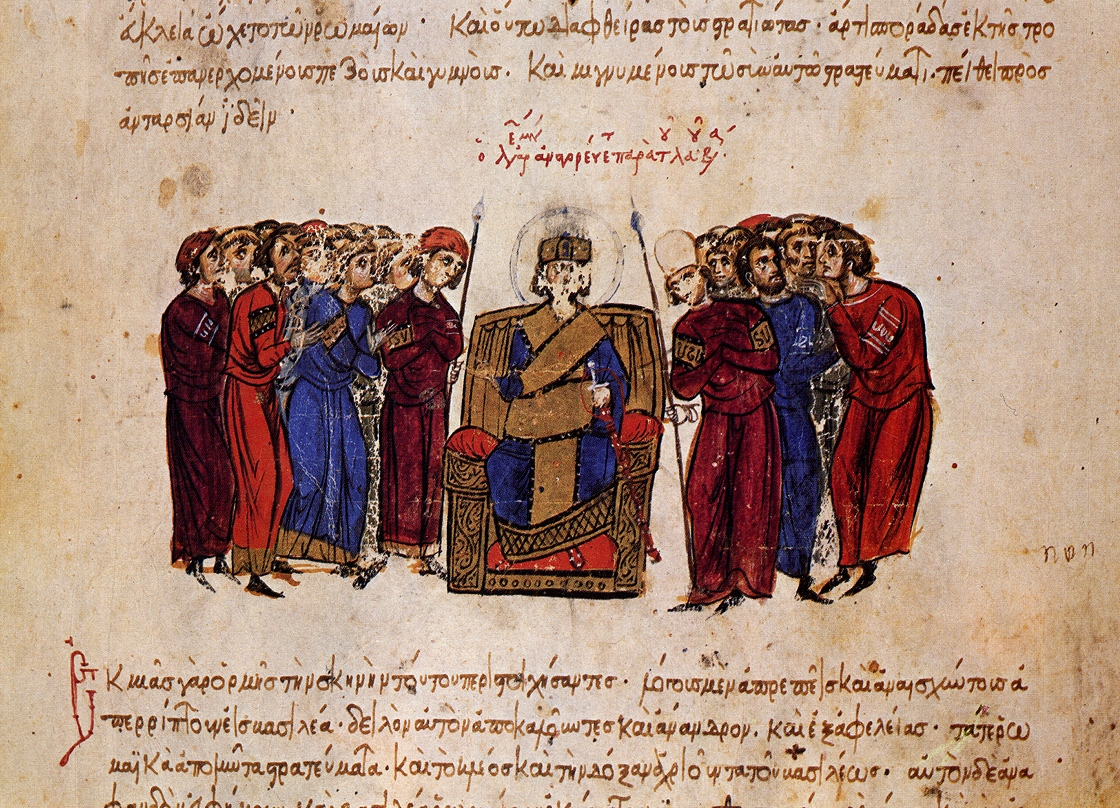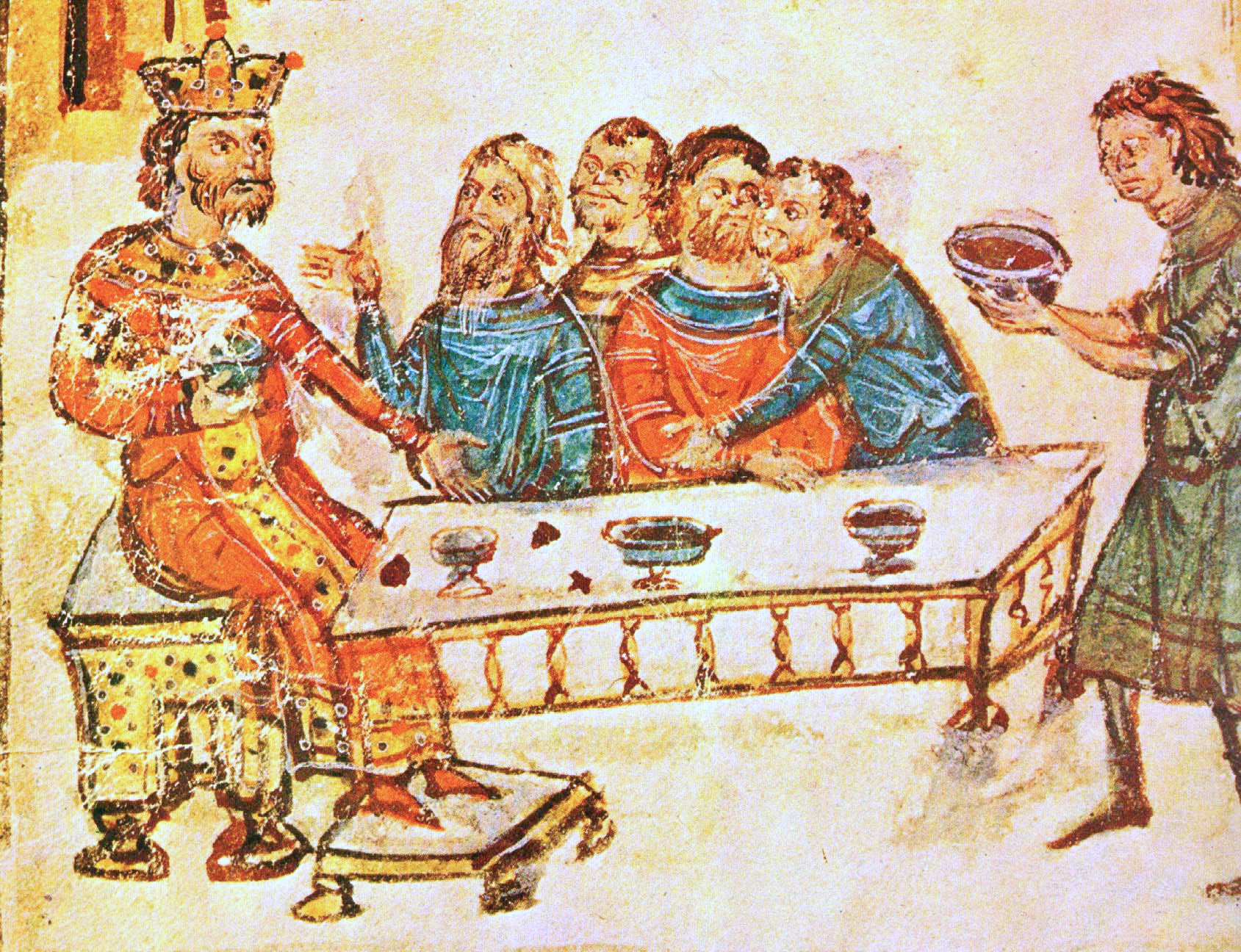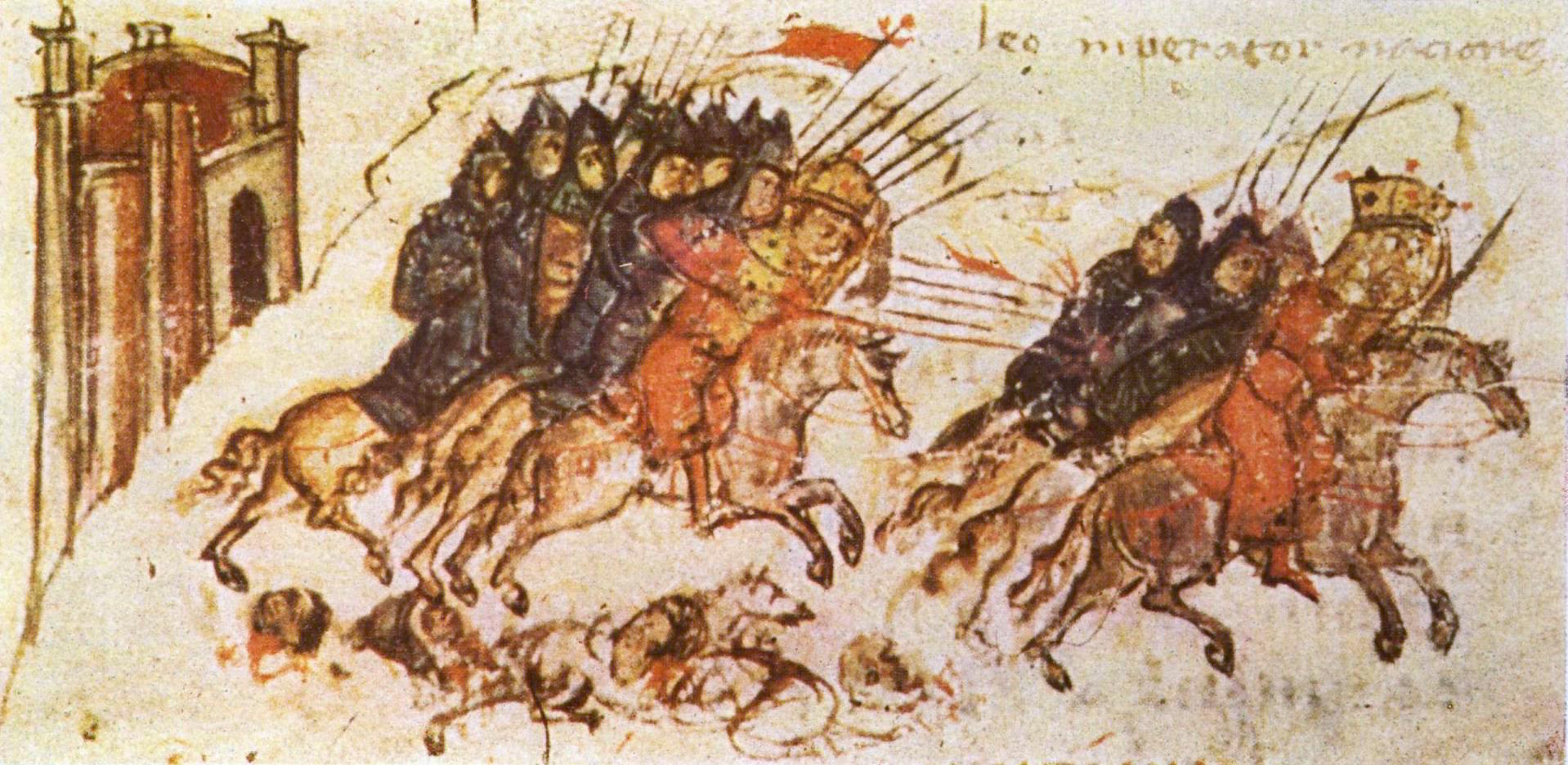|
813
Events By place Byzantine Empire * June 22 – Battle of Versinikia: The Bulgars, led by Krum, ruler ('' khan'') of the Bulgarian Empire, defeat Emperor Michael I near Edirne (modern Turkey). The Byzantine army (26,000 men) is destroyed by a counter-attack of Bulgarian heavy cavalry, while trapped in the valley. Krum captures the Byzantine camp and a rich prize, including gold and weaponry. * July 11 – Michael I, under threat by conspiracies, abdicates in favor of his general Leo the Armenian, and becomes a monk (under the name Athanasius). His sons are castrated to prevent them succeeding the Byzantine throne, and relegated into monasteries. One of them, Niketas (renamed Ignatius), eventually becomes a patriarch of Constantinople. * July 17 – Krum reaches Constantinople, and sets his camp outside the walls. He is given an invitation, and a promise of safe conduct, to meet Leo V. Krum sets out unarmed for the capital with only a small escort, but i ... [...More Info...] [...Related Items...] OR: [Wikipedia] [Google] [Baidu] |
Battle Of Versinikia
Bulgarian Battle of Versinikia (; ) was a battle fought in 813 AD between the Byzantine Empire and the Bulgarian Empire, near the city of Adrianople (Edirne), in modern-day Turkey. The Bulgarian army, led by Krum of Bulgaria, defeated the Byzantine forces. Following this defeat, Michael I Rangabe abdicated, with Leo V the Armenian taking the Byzantine throne. The battle further strengthened Bulgarian control in the region after their victory over Nikephoros I two years earlier. After the battle, the Bulgarians controlled the whole region of Eastern Thrace (until the Byzantine–Bulgarian Treaty of 815), with the exception of a few castles that remained in Byzantine control. Krum died on 13 April 814, but his muster of "5,000 iron-plated wagons . . . to carry the siege equipment." alarmed the Byzantine court to such an effect that they asked for the aid of the Carolingian Emperor Louis the Pious. These large-scale military preparations were Krum's attempt to avenge his failure ... [...More Info...] [...Related Items...] OR: [Wikipedia] [Google] [Baidu] |
Michael I Rangabe
Michael I Rangabe (also spelled Rhangabe; ; c. 770 – 11 January 844) was Byzantine emperor from 811 to 813. A courtier of Emperor Nikephoros I (), he survived the disastrous campaign against the Bulgars and was preferred as imperial successor over Staurakios (), who was severely injured. He was proclaimed emperor by Patriarch Nicephorus I of Constantinople on 2 October 811. Michael's policies were generally conciliatory, and he was overwhelmingly influenced by the iconodule clerics Nikephoros and Theodore the Stoudite. He improved relations with the Franks, even to the point of recognising Charlemagne as an emperor – although not "of the Romans" – and requesting papal arbitration in the Moechian controversy. His half-hearted leadership of the campaign against the Bulgars resulted in defeat in the Battle of Versinikia. The '' stratēgos'' of the Anatolic Theme, Leo the Armenian, a popular and successful general, abandoned Michael on the battlefield but was proclaim ... [...More Info...] [...Related Items...] OR: [Wikipedia] [Google] [Baidu] |
Leo V The Armenian
Leo V the Armenian (, ''Léōn ho Arménios''; 775 – 25 December 820) was the Byzantine emperor from 813 to 820. He is chiefly remembered for ending the decade-long war with the First Bulgarian Empire, Bulgars, as well as initiating the second period of Byzantine iconoclasm. A senior general of Armenian origin, Leo distinguished himself under Nikephoros I and Michael I Rhangabe, eventually becoming the ''strategos, stratēgos'' of the Anatolic Theme. Taking advantage of Michael's defeat at the Battle of Versinikia, he forced the emperor to abdicate in his favour. He was able to withhold the Siege of Constantinople (813), blockade of Constantinople by Krum, Krum of Bulgaria and, after Krum's death, concluded a Byzantine–Bulgarian treaty of 815, 30-year peace with his successor Omurtag of Bulgaria, Omurtag. In 815, Leo deposed Patriarch Nikephoros I of Constantinople, Nikephoros and reinstituted iconoclasm. He was assassinated by supporters of Michael II, Michael the Amorian, ... [...More Info...] [...Related Items...] OR: [Wikipedia] [Google] [Baidu] |
Turkey
Turkey, officially the Republic of Türkiye, is a country mainly located in Anatolia in West Asia, with a relatively small part called East Thrace in Southeast Europe. It borders the Black Sea to the north; Georgia (country), Georgia, Armenia, Azerbaijan, and Iran to the east; Iraq, Syria, and the Mediterranean Sea to the south; and the Aegean Sea, Greece, and Bulgaria to the west. Turkey is home to over 85 million people; most are ethnic Turkish people, Turks, while ethnic Kurds in Turkey, Kurds are the Minorities in Turkey, largest ethnic minority. Officially Secularism in Turkey, a secular state, Turkey has Islam in Turkey, a Muslim-majority population. Ankara is Turkey's capital and second-largest city. Istanbul is its largest city and economic center. Other major cities include İzmir, Bursa, and Antalya. First inhabited by modern humans during the Late Paleolithic, present-day Turkey was home to List of ancient peoples of Anatolia, various ancient peoples. The Hattians ... [...More Info...] [...Related Items...] OR: [Wikipedia] [Google] [Baidu] |
Siege Of Constantinople (813)
The siege of Constantinople in 813 () by Khan Krum () was a failed attempt to take the city during the Bulgarian-Byzantine wars. The siege After the Battle of Versinikia (or Second Battle of Adrianople) on 22 June 813, which was a defeat for the Byzantines, Krum's cavalry pursued them and taking advantage of this defeat, Krum advanced towards the walls of Constantinople. Michael I Rangabe was forced to abdicate and become a monk, becoming the third Byzantine emperor removed by Krum since 811. Krum arrived at the city on 17 July 813, and performed a pagan sacrificial ritual involving animals and people in order to impress and force the defenders to surrender. But it was a failure and when Krum saw that the walls were impregnable, he decided to propose peace to the new Byzantine emperor Leo V the Armenian. Krum proposed a meeting, but the Byzantines had set a trap, and he was wounded by archers but managed to flee. Furious, Krum ravaged the environs of Constantinople on the wa ... [...More Info...] [...Related Items...] OR: [Wikipedia] [Google] [Baidu] |
Siege Of Adrianople (813)
The siege of Adrianople () in 813 was a part of the wars of the Byzantine Empire with the Bulgarian khan Krum ( Byzantine-Bulgarian Wars). It began soon after the Byzantine field army was defeated in the battle of Versinikia on 22 June. At first the besieging force was commanded by Krum's brother (whose name is not mentioned in the primary sources). The khan himself went on with an army to besiege Constantinople. After an unsuccessful Byzantine attempt to murder him ruined all prospects for negotiations with them, Krum ravaged much of Eastern Thrace and then turned against Adrianople which was still under siege. The city—one of the most important Byzantine fortresses in Thrace—held out for a while despite being attacked with siege engines. Yet, without any help from outside, the garrison was forced to capitulate due to starvation. On Krum's orders, the population of Adrianople and the surrounding area (numbering about 10,000) was transferred to Bulgarian territory north ... [...More Info...] [...Related Items...] OR: [Wikipedia] [Google] [Baidu] |
Krum
Krum (, ), often referred to as Krum the Fearsome () was the Khan of Bulgaria from sometime between 796 and 803 until his death in 814. During his reign the Bulgarian territory doubled in size, spreading from the middle Danube to the Dnieper and from Odrin to the Tatra Mountains. His able and energetic rule brought law and order to Bulgaria and developed the rudiments of state organization. Biography Origins Krum was a Bulgar chieftain from Pannonia. His family background and the surroundings of his accession are unknown. It has been speculated that Krum might have been a descendant of Khan Kubrat through his son Kuber. The Bulgar name Krum comes from the Old Turkic ''qurum'' and means "ruler". Establishment of new borders Around 805, Krum defeated the Avar Khaganate to destroy the remainder of the Avars and to restore Bulgar authority in Ongal again, the traditional Bulgar name for the area north of the Danube across the Carpathians covering Transylvania and along t ... [...More Info...] [...Related Items...] OR: [Wikipedia] [Google] [Baidu] |
June 22
Events Pre-1600 *217 BC – Battle of Raphia: Ptolemy IV Philopator of Egypt defeats Antiochus III the Great of the Seleucid kingdom. *168 BC – Battle of Pydna: Roman Republic, Romans under Lucius Aemilius Paullus Macedonicus, Lucius Aemilius Paullus defeat Macedonia (ancient kingdom), Macedonian King Perseus of Macedon, Perseus who surrenders after the battle, ending the Third Macedonian War. * 331 – The Council of Ephesus, the third ecumenical council, begins, dealing with Nestorianism. * 813 – Battle of Versinikia: The Bulgars led by Krum defeat the Byzantine Empire, Byzantine army near Edirne. Emperor Michael I Rangabe, Michael I is forced to abdicate in favor of Leo V the Armenian. * 910 – The Hungarians defeat the East Francia, East Frankish army near the Rednitz, Rednitz River, killing its leader Gebhard, Duke of Lorraine, Gebhard, Duke of Lotharingia (Lorraine). *1527 – Fatahillah expels Portuguese Empire, Portuguese forces from Sunda ... [...More Info...] [...Related Items...] OR: [Wikipedia] [Google] [Baidu] |
Castration
Castration is any action, surgery, surgical, chemical substance, chemical, or otherwise, by which a male loses use of the testicles: the male gonad. Surgical castration is bilateral orchiectomy (excision of both testicles), while chemical castration uses pharmaceutical drugs to deactivate the testes. Some forms of castration cause sterilization (medicine), sterilization (permanently preventing the castrated person or animal from reproduction, reproducing); it also greatly reduces the production of hormones, such as testosterone and estrogen. Surgical castration in animals is often called neutering. #Other animals, Castration of animals is intended to favor a desired development of the animal or of its habits, as an anaphrodisiac or to prevent overpopulation. The parallel of castration for female animals is spaying. Castration may also refer medically to oophorectomy in female humans and animals. The term ''castration'' may also be sometimes used to refer to emasculation where ... [...More Info...] [...Related Items...] OR: [Wikipedia] [Google] [Baidu] |
Thrace
Thrace (, ; ; ; ) is a geographical and historical region in Southeast Europe roughly corresponding to the province of Thrace in the Roman Empire. Bounded by the Balkan Mountains to the north, the Aegean Sea to the south, and the Black Sea to the east, it comprises present-day southeastern Bulgaria (Northern Thrace), northeastern Greece (Western Thrace), and the European part of Turkey (East Thrace). Lands also inhabited by ancient Thracians extended in the north to modern-day Northern Bulgaria and Romania and to the west into Macedonia (region), Macedonia. Etymology The word ''Thrace'', from ancient Greek ''Thrake'' (Θρᾴκη), referred originally to the Thracians (ancient Greek ''Thrakes'' Θρᾷκες), an ancient people inhabiting Southeast Europe. The name ''Europe'' (ancient Greek Εὐρώπη), also at first referred to this region, before that term expanded to include its Europe, modern sense. It has been suggested that the name ''Thrace'' derives from the na ... [...More Info...] [...Related Items...] OR: [Wikipedia] [Google] [Baidu] |
Bulgars
The Bulgars (also Bulghars, Bulgari, Bolgars, Bolghars, Bolgari, Proto-Bulgarians) were Turkic peoples, Turkic Nomad, semi-nomadic warrior tribes that flourished in the Pontic–Caspian steppe and the Volga region between the 5th and 7th centuries. They became known as Eurasian nomads, nomadic equestrians in the Volga-Ural region, but some researchers trace Bulgar ethnic roots to Central Asia. During their westward migration across the Eurasian Steppe, the Bulgar tribes absorbed other tribal groups and cultural influences in a process of ethnogenesis, including Iranian peoples, Iranic, Finno-Ugric peoples, Finno-Ugric, and Huns, Hunnic tribes. The Bulgars spoke a Turkic languages, Turkic language, the Bulgar language of the Oghur languages, Oghuric branch. They preserved the military titles, organization, and customs of Eurasian steppes as well as pagan shamanism and belief in the sky deity Tengri, Tangra. The Bulgars became semi-sedentary during the 7th century in the Pontic- ... [...More Info...] [...Related Items...] OR: [Wikipedia] [Google] [Baidu] |





